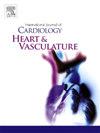Ten-year outcomes after transcatheter or surgical aortic valve replacement in low-risk patients: The OBSERVANT study
IF 2.5
Q2 CARDIAC & CARDIOVASCULAR SYSTEMS
引用次数: 0
Abstract
Background
The evidence of the long-term advantages of transcatheter aortic valve replacement (TAVR) over surgical aortic valve replacement (SAVR) for aortic stenosis (AS) remains scarce.
Methods
Patients with EuroSCORE II < 4 % who underwent TAVR or SAVR for AS from the prospective observational OBSERVANT study were included in this analysis. Ten-year survival was the primary outcome of this analysis. Secondary outcome was repeat procedure on the aortic valve prosthesis.
Results
Propensity score matching resulted in 355 matched pairs of patients who underwent TAVR or SAVR. The mean age of SAVR patients was 80.0 ± 5.1 years and that of TAVR patients 80.1 ± 6.4 years (p = 0.81) and the mean EuroSCORE II was 2.5 ± 0.8 % and 2.6 ± 0.8 % (p = 0.60), respectively. Thirty-day mortality was 2.8 % after SAVR and 2.5 % after TAVR (p = 0.82). At 10-year, survival was 37.0 % (95 %CI 32.2–42.5 %) after SAVR and 18.2 % (95 %CI 14.5–22.8 %) after TAVR (Log-rank test, p < 0.001; HR 1.70, 95 %CI 1.42–2.03). Difference in terms of survival between the propensity matched cohorts became significant 3 years after the procedures. Ten-year cumulative incidences of repeat aortic valve procedure were 2.6 % (95 %CI 1.4–5.0 %) after SAVR and 1.1 % (95 %CI 0.4–3.0 %) after TAVR (p = 0.153; SHR 0.43, 95 %CI 0.13–1.41).
Conclusions
The results of this prospective observational, non-randomized study showed that 10-year survival of low-risk patients who underwent TAVR with early generation prosthesis devices was lower than SAVR.
低风险患者经导管或手术主动脉瓣置换术后的十年预后:OBSERVANT 研究
背景经导管主动脉瓣置换术(TAVR)相对于手术主动脉瓣置换术(SAVR)治疗主动脉瓣狭窄(AS)的长期优势的证据仍然很少。方法本分析纳入了前瞻性观察性 OBSERVANT 研究中接受 TAVR 或 SAVR 治疗 AS 的 EuroSCORE II < 4 % 患者。十年生存率是本次分析的主要结果。次要结果是主动脉瓣假体的重复手术。结果 通过倾向评分匹配,355 对患者进行了 TAVR 或 SAVR。SAVR患者的平均年龄为(80.0 ± 5.1)岁,TAVR患者的平均年龄为(80.1 ± 6.4)岁(P = 0.81),平均EuroSCORE II分别为(2.5 ± 0.8)%和(2.6 ± 0.8)%(P = 0.60)。SAVR术后30天死亡率为2.8%,TAVR术后为2.5%(p = 0.82)。SAVR术后10年生存率为37.0%(95 %CI 32.2-42.5%),TAVR术后10年生存率为18.2%(95 %CI 14.5-22.8%)(Log-rank检验,p < 0.001; HR 1.70, 95 %CI 1.42-2.03)。倾向匹配队列之间的生存率差异在术后 3 年变得显著。SAVR术后十年主动脉瓣重复手术累积发生率为2.6%(95 %CI 1.4-5.0%),TAVR术后为1.1%(95 %CI 0.4-3.0%)(p = 0.153;SHR 0.43,95 %CI 0.13-1.41)。
本文章由计算机程序翻译,如有差异,请以英文原文为准。
求助全文
约1分钟内获得全文
求助全文
来源期刊

IJC Heart and Vasculature
Medicine-Cardiology and Cardiovascular Medicine
CiteScore
4.90
自引率
10.30%
发文量
216
审稿时长
56 days
期刊介绍:
IJC Heart & Vasculature is an online-only, open-access journal dedicated to publishing original articles and reviews (also Editorials and Letters to the Editor) which report on structural and functional cardiovascular pathology, with an emphasis on imaging and disease pathophysiology. Articles must be authentic, educational, clinically relevant, and original in their content and scientific approach. IJC Heart & Vasculature requires the highest standards of scientific integrity in order to promote reliable, reproducible and verifiable research findings. All authors are advised to consult the Principles of Ethical Publishing in the International Journal of Cardiology before submitting a manuscript. Submission of a manuscript to this journal gives the publisher the right to publish that paper if it is accepted. Manuscripts may be edited to improve clarity and expression.
 求助内容:
求助内容: 应助结果提醒方式:
应助结果提醒方式:


